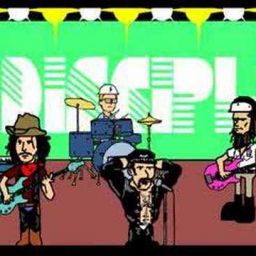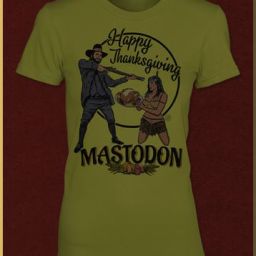
It was one of the few books that I feel gives metal an honest, critical examination that’s free of the usual sweeping generalizations that seem to come with a lot of writing about metal, as a genre and a subculture. You know what I’m talking about: people thinking it’s just noise, appealing to only numbskulled, uneducated teenagers, and so forth.
As a metal fan, good books on the genre are hard to find, I’m looking forward to Bazillion Points expanding the critical coverage of heavy metal – the music, the musicians, the fans. There’s a lot to cover, as it’s a scene that’s quite active and diverse, despite very little mainstream airplay or major label support. As a writer and publishing geek, I’m interested in how this DIY company is going for a pretty narrow niche (but dedicated) audience, kind of like blogs. I’m pretty sure this approach is going to be the future of the print publishing industry. I sent Christe an e-mail last week and asked him for a phone interview. Here’s some of our chat:
Keidra: So without getting too fangirly on you I just wanted to tell you that Sound of The Beast is one of my favorite music criticism books.
Ian Christe: Yeah, thanks. It had to be done, it was about 10 years overdue when I started writing it. It just seems so obvious of a topic.
K: Yeah, I feel like it’s kind of a red-headed stepchild, like there’s a feeling that it’s not worthy of exploration, and I feel like the book gives the genre some critical legitimacy. Was that a big motivation to start Bazillion Points?
IC: It was borne of frustration for sure, even though I think Sound of The Beast was a success by mainstream publishing standards it didn’t make it make it any easier [to get a book on metal] the second time around. I knew a lot of writers who were experts on different subsections of metal, like Jeff Wagner with progressive metal and Jon Kristiansen, “Metalion” from (extreme metal ‘zine) Slayer Magazine, and these guys would never get a mainstream book deal, and yet if you look at other genres like 70’s folk rock, something that’s very micro-niche, and there’s like two dozen books about it, because it appeals to the sensibilities of many book editors, it seems like a safe bet. Meanwhile, the progressive metal scene is thriving, obviously black metal is thriving.
I felt like it’s a very frustrating process to work with a mainstream publisher anyway, and you do about 90% of the work yourself. I learned a lot from doing Sound of the Beast and the Van Halen book [Everybody Wants Some: The Van Halen Saga, 2007], and basically I felt like there’s only a few aspects of the [publishing] industry that I don’t know anything about, so I think I can probably learn those and fill a void, you know?
K: There’s a big fanbase for this kind of stuff that’s probably not on the radar of a lot of publishers. Even within mainstream music magazines there’s not a whole lot of options.
IC: There’s a lot of talented music writers writing for the metal magazines, but where do they go outside of that, I dunno? How do you break out of that, where do you go next? It’s tough.
K: Are you working on any kind of follow up to Sound of the Beast through Bazillion Points? A lot’s gone on since 2003.
IC: Nomit still belongs to Harper Collins, the only thing I can do is release it in a language it hasn’t already been licensed in, which I thought about .. but right now there’s about 15 translations, and in the past 15 months, they’ve licensed to Japan, Italy, Portugal, which includes Brazil. Those were the three big translations that I wanted to see, and it took six years for that to happen, but I am perfectly happy to let Harper Collins continue to do what they’re doing. I still think they are super surprised, though. I think the reason they were happy about the book coming out when it did was because “The Osbournes” [TV show] was really popular at the time.
K: Oh wow…
IC: It kinda showed their awareness of heavy metal. But that’s OK, metal is supposed to be underground, it’s supposed to kind of an outsider appeal.
K: Yeah, but it’s funny because now you’ve got all these documentaries out now that have done pretty well: Metal: A Headbanger’s Journey was on VH1, the Global Metal sequel, Heavy Metal in Baghdad. Has that helped Bazillion Points at all?
IC: Not as far as I know, it’s helped me get on random VH1 documentaries on metal, and get back in touch with people I haven’t seen since elementary school by being on those shows, I guess it does impress people in someway, makes me seem more legitimate than I really am [laughs] actually I think the big cultural motor right now for heavy music is Guitar Hero. Metal’s kind of in danger of taking itself too seriously, so now you’ve all these goofy 14-year-olds flopping around to the stuff. Assuming that maybe later these kids start getting into bands like Dragonforce or something; To come from a place that dorky its kind of important.
K: I feel like most metalheads usually start out dorky to begin with, I think there tends to be a big correlation between being dorky and liking metal.
IC: Yeah, the whole outsider thing, definitely, dorks are welcome!
K: So I know you’ve got the Slayer book, a book on Nightwish, what else is planned for Bazillion Points in 2009? I know there’s one on prog metal…
IC: The progressive metal book comes out in fall 2009. In general, I’m taking on new books as I can handle them, the next one for sure will be the [biography] of Andy McCoy from Hanoi Rocks. That was actually the very first book we were working on, it’s just taken longer for different reasons, first being that it had to be translated from Finnish. Hanoi Rocks, next to Van Halen, were probably the biggest inspiration to the glam metal scene in Hollywood in the 80’s, yet they were basically a bunch of homeless, Finnish Gypsys living in a subway station in Stockholm. They’re the real deal, and Andy McCoy is a pretty interesting guy. The book originally came out in the 90’s and Hanoi Rocks has kind of comeback and started playing a lot of festivals since then.
I’m working on a metal logos book with [artist] Mark Riddick, who’s done a lot of metal logos (Decesased, Dethklok, God Forbid, The Faceless, Black Dahlia Murder).
I was working on my own book and found out that he self-published his own book on a smaller scale, so we joined forces. He a designer, so talks about them in terms of headers and descenders and scaling, it’s really great.
Part 2 next week! More about Nightwish, fan culture, micro-niche publishing, and other stuff.







Visit http://www.moshbook.com – a social network just for metalheads. It is based on Facebook but better!